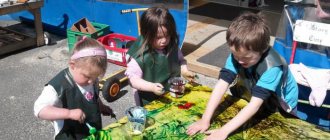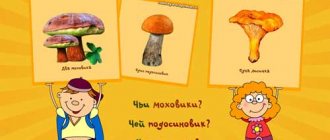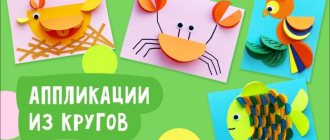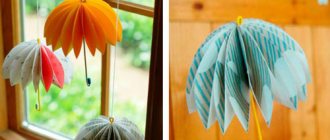Introducing children 2-3 years old to the seasons
Spring has come: the trees have grown (we stand straight, arms down)
Branches appeared on them (raise the arms up)
The leaves have blossomed on the branches (we spread our fingers in different directions)
Autumn is coming: the leaves have turned yellow (we bend our fingers and lower our hands a little)
A strong wind blew (we swayed our whole body and blew - ooooooo)
The leaves trembled in the wind (we shake our hands)
And the leaves fell to the ground (we bend over and reach the floor with our hands)
Winter is coming: Snow falls in winter (handles in front of us and waving our hands)
It’s getting cold (we show how cold it is: arms crossed on the chest and shaking)
All children wear hats and fur coats (we depict how we dress them)
And finally spring comes and new trees grow again (we show below how they hatch)
And they grow big - big (we straighten up, stand on tiptoes and raise our arms high above our heads)
Seasons
If the snowstorms end, if the birds suddenly start singing, the forest wakes up from sleep, then SPRING has come to us. If the sun is blue, and flowers bloom in the grass, if everything is warm, then SUMMER is coming to us. If the leaves are yellow, if the grass is dry, if the kids are going to school, it means AUTUMN is in the yard. If it’s cold all around, if the river is under ice, everything is covered in snow: the ground, the houses, then WINTER has come to us. If the house is brightly decorated, if everyone is given gifts, if there is a Christmas tree, a round dance - this is a New Year holiday!
Here he is floating in the spring - The sound of drops in the silence. At night he sails and during the day, As nature dictates, Through the seas that we call the Seasons.
(L. Zavalnyuk)
Months of the year
January
Open the calendar - January begins.
In January, in January There is a lot of snow in the yard.
Snow - on the roof, on the porch. The sun is in the blue sky. The stoves are heated in our house. Smoke rises into the sky in a column.
February
The winds blow in February, the chimneys howl loudly. Light drifting snow rushes along the ground like a snake.
Rising, flights of planes rush into the distance. This February celebrates the birth of the Army.
March
The loose snow darkens in March. The ice on the window is melting. The bunny runs around the desk and on the map on the wall.
April
April, April! Drops are ringing in the yard.
Streams run through the fields, There are puddles on the roads. The ants will soon come out after the winter cold.
A bear makes his way through the dead wood. The birds began to sing songs, and the snowdrop blossomed.
May
The lily of the valley blossomed in May On the very holiday - on the first day. Seeing off May with flowers, lilacs are blooming.
June
June has arrived. "June! June!" - Birds are chirping in the garden... Just blow on a dandelion and it will all fly away.
July
Haymaking begins in July, Somewhere thunder sometimes grumbles. And the young bee swarm is ready to leave the hive.
August
We collect the fruit harvest in August. There is a lot of joy for people after all the work.
The sun is standing over the spacious Niva. And the sunflower is filled with black grains.
September
On a clear September morning, the villages are threshing grain, birds are rushing across the seas - and the school opened.
October
In October, in October Frequent rain outside.
The grass in the meadows is dead, the grasshopper has fallen silent. Firewood has been prepared for the stoves for the winter.
November
The seventh day of November is the Red Day of the calendar. Look out your window: Everything on the street is red.
The flags flutter at the gates, blazing with flame. You see, the music goes Where the trams went.
All the people - both young and old - Celebrate freedom. And my red ball flies straight to the sky!
December
In December, in December All the trees are in silver.
Our river, as if in a fairy tale, was paved with frost overnight, renewed skates and sleds, and brought a Christmas tree from the forest.
The Christmas tree cried at first from the warmth of home. In the morning she stopped crying, started breathing, came to life.
Its needles are trembling slightly, the lights are lit on the branches. Like on a ladder, on a Christmas tree, the lights run up.
Firecrackers sparkle with gold. The bravest light that reached the top lit the star with silver.
(S. Marshak)
Summary of the extracurricular lesson “Seasons” for elementary school children
Lesson summary in additional education: “Seasons” for children 7 - 12 years old
Author: Osinovskaya Natalia Yuryevna, teacher of the Municipal Educational Institution “Syavskaya Correctional School - Boarding School”, Nizhny Novgorod region, g.o.g. Shakhunya, Syava village. Description of work: the lesson is intended for children 7-12 years old. Systematize children's knowledge about the sequence of seasons, clarify ideas about the characteristic features of each season. To form ideas about the regular repeatability of changes in the life of nature from season to season. To revive children's impressions of encounters with vivid natural phenomena at different times of the year. Goal: to systematize children’s knowledge about the seasons. Objectives: 1. Educational: •consolidate knowledge about the seasons, activate children’s vocabulary on the topics: winter, spring, summer, autumn; •distinguish and name the essential signs of the seasons; •group signs and objects according to their correspondence according to the symbol; •continue to teach children the question-and-answer form of conversation, to answer in full sentences of different constructions; •strengthen the skills of forming possessive adjectives; •continue to teach how to work with diagrams; •consolidate knowledge of trees, find the corresponding leaves in the exercise “Recognize and name”; •intensify mental activity at the level of monologue, dialogic speech, abbreviated internal speech to oneself. 2.Developing: •develop systematic thinking in the process of expanding knowledge about the seasons; •develop graphic skills; •develop attention, perception; 3. Educational: •to cultivate observation, curiosity, patience. Be able to identify the main signs of seasonal phenomena. Equipment: Multimedia projector, screen;
didactic games: “Magic bag”, “Create a figure”, “Which tree is the leaf from”, “Who lives where?” demonstration, story pictures (seasons). Progress of the lesson:
Educator: Hello guys! The topic of our lesson: “Seasons” - Guys, remember we read the fairy tale: “Twelve Months.”
- Who remembers what the months are called? Answers: (January, February, March, April, May, June, July, August, September, October, November, December). Educator: - As soon as one month ends, another begins immediately. And it has never happened before that February would come before January left, and May would overtake April. - The months go one after another and never meet. And all these 12 months were seen by one girl, in winter, in January. She asked them to help collect snowdrops in the basket. — Is it possible to find snowdrops in winter? Answer: (no)
- After the girl told her story: how her stepmother sent her into the winter forest for snowdrops, and told her not to return without them, otherwise it would be bad. “The months whispered and decided to help the girl. They began to give up their places to each other. January gave way to February. February gave way to March. And the month of March gave the girl a basket of snowdrops.
And the girl, thanking for the help, ran home. — When the months began to return to their places, they became confused and their Seasons were mixed up.
Educator - Guys, let us help them so that the Seasons fall into place. - Shall we help? Answers: (yes) Educator: Children, look who is rushing to our aid? Autumn: - Guess who I am? Riddle: “I bring the harvests, I sow the fields again, I send the birds to the south, I strip the trees, But I don’t touch the pines and fir trees……(Autumn)”
Autumn: - Correct! Guys, tell me what three months do you know? Children's answers: (September, October, November) (the words appear on the board: Autumn, September, October, November) - What signs of autumn do you know? (Children go to the board and choose pictures - signs and hang them on the board: Signs: the harvest is being harvested, it is raining, the leaves of the trees change color and fall off, birds are flying to warm countries).
Autumn: - Well done! I'm glad that you know the signs of Autumn. Educator: - Let's repeat the signs of Autumn. Autumn: - And now I want to play with you. Game “Magic Bag” - You need to feel the object without peeking and say what it is. Who has the most sensitive fingers? (Beets, cucumber, tomato, cabbage, onion, garlic, carrots, potatoes, sweet peppers. Autumn: - Thank you guys. That you know so much about autumn. It’s time for me to get to my place. I have a lot of work. Goodbye! Physical education teacher : - I show birds and animals, and you must show with your hands who flies - hands up, and who doesn’t fly - hands down (crow, mouse, rook, sparrow, dog, cat, bear, hare, starling, ant and etc.) Winter appears. Winter: - Hello! Guess who I am? Riddle: "Cold weather has come, the water turned into ice. A long-eared gray bunny turned into a white bunny. The bear stopped roaring, the bear went into hibernation in the forest. Who can say who knows when this happens?" (In winter) Winter: - Guys, tell me what three months do you know? Answers: (December, January, February) - Well done! - What signs of winter do you know? (children go to the board, choose the signs of winter , explain and hang on the board) Signs: (the trees are bare, there is snow on them, it’s snowing, it’s cold, it’s New Year in winter, feeders are hung on the trees (they help birds so that they don’t die from cold and hunger) Children are skating, skiing, playing snowballs, making snowmen, dressing warmly).
- Well done! Educator: - Guys, let's repeat the signs of Winter. Winter: (takes out an envelope with geometric shapes) - I want to play with you, the game is called: “Invent a shape.” It is from these geometric shapes that you need to assemble a drawing.
And tell me what you did. Shapes: (snowflake, snowman, house, car, Christmas tree, etc.)
Winter: - Thank you guys for making me so happy, I had so much fun with you, but I have to go! Goodbye! Spring appears. Spring: - Hello! Guess who I am? Riddle: “I open the buds, dress the trees in green leaves, water the crops, I’m full of movement, my name is…….(Spring)”
Spring: - Guys, tell me what three spring months do you know? (March, April, May) - well done! What signs of Spring do you know? (children choose pictures - signs and hang them on the board) Signs: (it’s hot. The sun is shining, buds appear on the trees, leaves appear, snow melts, grass appears, the first flowers (snowdrops), birds arrive, it rains, people put on jackets and raincoats ).
Spring: - Well done! Educator: - Let's repeat the signs of Spring. Spring: - I want to play with you. Game: “Which tree is the leaf from?” (you must name the trees to which these leaves belong) (birch, oak, rowan, maple). Physical school “The wind is blowing in our faces The tree is swaying The breeze is getting quieter, quieter The tree is getting higher, higher!” Spring: - Thank you guys for knowing the signs of spring so well, knowing how to play, being friendly, helping each other. It's time for me to go back! Goodbye! Summer appears. Summer: Hello guys! Guess who I am? Riddle: “I am made of heat, I carry warmth with me, I warm the rivers, swim! I invite you! And you all love me for this, I……(Summer)"
Summer: - What three summer months do you know? (June, July, August) - Well done! – What signs of summer do you know? (children choose pictures - signs and hang them on the board0 Signs: (the sun is shining brightly, the trees are green, insects are flying, flowers are blooming. Mushrooms, berries are growing, you can swim, sunbathe, etc.)
Educator: - I’m very glad that you named all the signs of summer correctly, well done! Summer: I want to play with you. Game: “Who lives where?” scheme . Meadow. Water. bear grasshopper frog fox butterfly pike hare mouse fish (arrange the pictures in the correct columns) Summer: - Well done! You are very observant and know who lives where. - I must go, goodbye! Educator: - We helped you put everything in its place. Now there will be no confusion. - In winter, flowers will never grow, butterflies will never fly. - And in the summer it snows. - in autumn - snowdrops bloom and leaves bloom on the trees. - everyone has their own time and each Season has its own signs. - Let's repeat once again, let's name the seasons correctly: Autumn. Winter, Spring, Summer. - and for your help, for twelve months they gave you gifts: little books with stories about animals, about nature. Educator: - What did you like about the lesson? If you met 12 months in the forest, what would you talk to them about? - Thanks for good job!
We recommend watching:
Summary of a themed walk in elementary school. Nature has no bad weather Lesson notes for 9th grade students with presentation. Cartoning and bookbinding Summary of a lesson in writing and speech development in the 9th grade of a correctional school with a presentation Summary of a lesson in the 5th grade. Lake Chebarkul
Similar articles:
Tournament of Russian language experts, grades 2-3
MAGAZINE Preschooler.RF
Annual project in the senior group Topic: “Seasons”The project is being implemented within the framework of the “From Birth to School” edited by N.E. Veraksy, M.A. Vasilyeva, V.V. Gerbovaya, according to the Federal State Educational Standard.
“Good nature has taken care of everything so much that everywhere you find something to learn” Leonardo da Vinci.
Relevance.
Winter gives way to autumn, then spring comes and summer comes. Children ask why this happens? ...Why do trees sleep in winter? Why did the slide become smaller? Where did the thawed patches come from? How do “drifts squat?” . To answer these and other questions, I took this topic for my project.
Type of project: informational and creative.
Problem: developing children's skills to notice changes in nature; to develop the ability to establish simple connections between the phenomena of living and inanimate nature.
Project participants: middle school children, parents, teachers.
Goal: to promote the formation of elementary ideas about the seasons, its periodicity, to notice the simplest seasonal changes in nature, to monitor the weather, people’s clothing, to cultivate a desire to independently observe natural phenomena.
Tasks:
For the teacher: find effective forms and methods of working with children on this topic.
For children: to promote the formation of children's ideas about seasonal changes, recognize and name the seasons, highlight characteristic features, develop interest in observing objects and phenomena in nature.
For parents: increase pedagogical competence in environmental education of preschool children, pay attention to observing objects and natural phenomena.
Expected result:
For teachers: the professional level will increase. Effective forms and methods of working with children in addressing issues of environmental education will be found.
For children: the ability to notice and name changes in nature, name the seasons, and develop an interest in observing objects and natural phenomena will be developed.
For parents: parents’ competence in environmental education of children will increase, they will conduct observations in nature with children and take an active part in organizing the educational process.
Project implementation stages.
Stage I - preparatory (October)
Stage II - main (November-May)
Stage III - final (May-June)
OO integration:
- speech development
- artistic and aesthetic development.
Project Implementation Plan
Preparatory stage.
At the preparatory stage, I reviewed the works of L.I. Marchenko “Autumn” , “Winter” , “Spring” , “Summer” , which touched on the topic: “Seasons” . Methodological literature on this topic was also studied:
The program “From birth to school” edited by N.E. Veraksa, T.S. Komarova, M.A. Vasilyeva;
O.G. Zhukov “Subject environment. Sensory. Ecology" ;
I.V. Kravchenko “Walks in kindergarten” ;
O.A. Solomennikova “Lesson on the formation of elementary ecological ideas in the middle group of kindergarten” ;
S.N. Nikolaev “Young Ecologist” system of work in the middle group of kindergarten;
N.F. Gubanov “Development of gaming activities” .
I developed a plan for the implementation of the project, selected fiction, didactic and outdoor games, activities, and conversations.
Main stage.
The main stage includes the implementation of the main activities in the project area.
Conversations were held with the children: “Early Autumn” , “Golden Autumn” , “Late Autumn” - to consolidate the months of autumn, the signs of autumn. “Migratory birds” , “Wintering birds” - fix the names of migratory and wintering birds, the behavior of birds in winter. “Hello, winter-winter” - the ability to compare autumn and winter landscapes. “How animals prepare for winter” - how animals spend the winter. “New Year Holiday” - preparation for the New Year's party: memorizing poems and songs.
“Spring is coming towards us with quick steps” - highlight the signs of spring. “Meeting birds” - consolidate the name of migratory birds.
“Hello Summer” - expand children’s understanding of summer changes in nature.
Didactic games: “Which tree is the leaf from” , “Loto” , “Vegetables” , “Seasons” , “Fold the picture” , “What didn’t happen?” , "What changed?" , “Nonsense” , “Birds” - lotto, “Flowers” - lotto, “What grows where” , “When does this happen?” , "Riddles-answers" .
Outdoor games: “Sunshine and rain” , “Birds and a car” , “Cucumber, cucumber...” , “Falling leaves” , “Geese, you red-footed geese” , “Hares in the garden” , “Little white bunny” , “Two frosts” , “The snow is spinning” , “Catch up” , “Cheerful sparrow” , “Birds one, birds two” , “Cheerful stream” , “We are cheerful guys” , “Sparrows-crows” .
Finger games: “Salt the cabbage” , “Snow, snow” , “Frost” , “Snowball” , “Drops” , “Spring” , “Flowers” .
Role-playing games: “Cooking soup” , “Zaykin’s garden” , “Hospital” , “Shop” , “Journey to the winter forest” , “We are going to relax on the river” .
Poems memorized: And Bunin “Leaf Fall” , A. Maykov “Autumn Leaves Are Whirling in the Wind” , Tuvim “Vegetables” , M. Poznanskaya “First Snow” , I. Surikova “Winter” , Orlova “The Bear is Sleeping” , I. Polyakov “ The sun came out from behind a cloud” , M. Klokova “Winter has passed” .
Nursery rhymes: “Legs, legs, where have you been?” , “Bucket Sun” and others.
Stories: V. Bianchi “The Foundling” , The First Hunt”, “Titmouse’s Calendar” , “Red Hill” , “Houses Without an Axe” . E. Charushin: “What kind of animal?” . D. Mamin-Sibiryak “The Tale of Komar Komarovich-Long Nose...” , “Gray Neck”
Fairy tales: “Winter quarters of animals” , “Hare and fox” , “Snow Maiden” , “War of mushrooms and berries”, processed by V. Dal.
The following EODs were carried out:
Drawing: “Goodbye, summer!” , “The apples are ripe” , “Snow Maiden” , “New Year’s card” , “New Year’s decorations” , “The birds have flown” , “Flowers for mom” .
Application: “Basket with mushrooms” , “Flowers for mom” .
Holidays: “Golden Autumn” , “New Year is in a hurry to us” , “Mom’s beloved” .
Entertainment: “Strong, fast, dexterous” , Farewell to winter.”
Practical activities: We made gifts for mothers, crafts from natural materials, and New Year's decorations.
Word games: “Vegetables” , “Golden Autumn” , “One is many” , “Say kindly” , “Tell me which one?” , “Burn, burn clearly” , “Spring is coming” , “What’s the beginning, what’s next?” .
Compilation of stories: “Winter” , “Autumn” , “Summer”, “Spring” .
The final stage.
The result of our project was the production of a model “Seasons” , a selection of educational games on this topic, and design of albums on the topic: “Seasons” .
Summing up the results of the “Seasons” , I noted that parents began to show more interest in the issue of environmental education, conduct observations in nature with their children, and draw their children’s attention to seasonal changes. Parents began to listen to our advice and became more demanding of themselves.
As a result of working on the project, children are able to notice and name changes in nature, name the seasons, observe objects and phenomena in nature, and have developed the ability to establish simple connections between the phenomena of living and inanimate nature.
Literature:
- L.I. Marchenko “Autumn” , “Winter” , “Spring” , “Summer” - Ufa, Kitap, 2004.
- The program “From birth to school” edited by N.E. Veraksy, T.S. Komarova, M.A. Vasilyeva. -Mosaic-Synthesis Moscow, 2012.
- O.G. Zhukov “Subject environment. Sensory. Ecology. - “Arkti” Moscow, 2007.
- I.V. Kravchenko "Walks in kindergarten" . - Sphere shopping center Moscow, 2009.
| Next > |
Books about the seasons
- Series “Town” by Susanne Rotraut Berner. Spring, Winter, Summer, Autumn. These are books without words. You look at them and come up with stories yourself. There are a lot of characters in the pictures, which are very interesting to look for and not always easy to find.
- “Titmouse Calendar” by Bianchi.
- Vladimir Svechnikov “Seasons. Illustrated Encyclopedia".
- Elena Ulyeva “Creative tasks. Seasons".
- Tatyana Romanova “We play in the seasons. 40 savvy ideas for kids."
- S. Marshak “All year round.”
- Alexander Golubev “Summer Adventures of Klevik” (there is a book about winter, spring and autumn).





